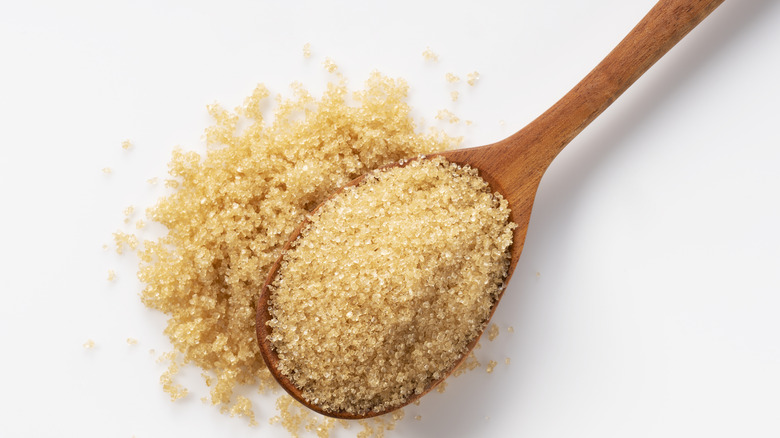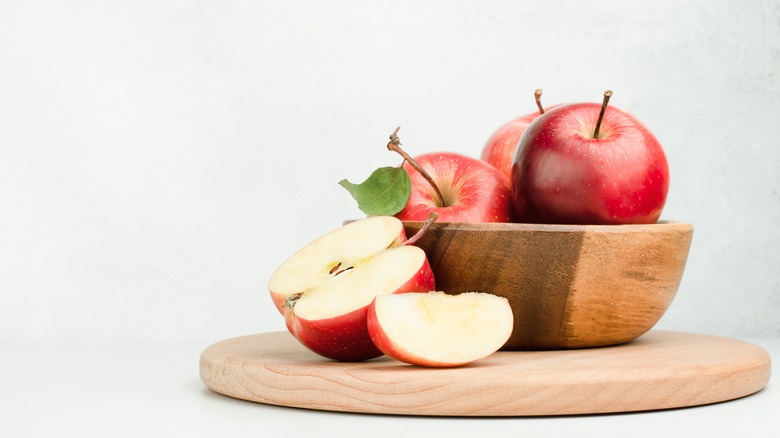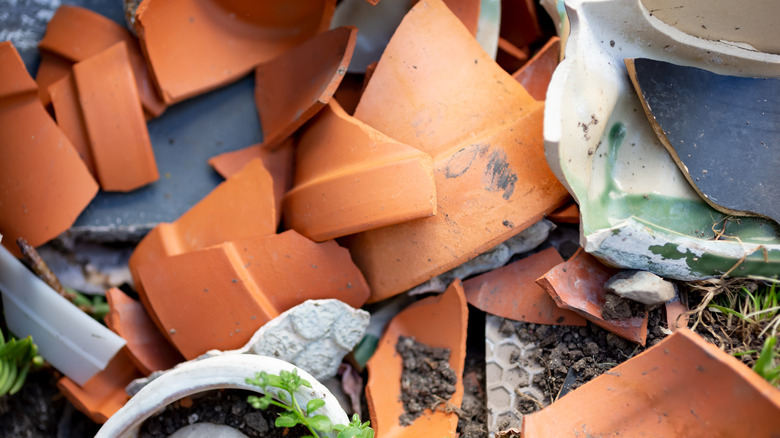The Fruit Slice Hack For If You Need To Soften Your Brown Sugar
Brown sugar is a staple of any kitchen pantry and to no surprise. Its deeply sweet flavor and attractive caramel color make it a perfect choice in confections like cookies and cakes, in dinners such as pork roasts, and in glazes. But while brown sugar is a delicious ingredient that adds a touch of bold sweetness to sugary or savory dishes, it may be a bit hard to use if you don't store it the right way.
As Food Network explains, brown sugar's unique flavor and color are thanks to the addition of molasses, which helps to give the sugar its "sandy," moist, texture. If brown sugar is stored improperly, the molasses and the resulting moisture will evaporate, allowing the sugar to pack together and solidify. This means that the next time you pull the brown sugar out, you basically get a dense brown sugar-flavored brick, a single solid cube that you have to chip at rather than scoop out.
Fortunately, there are many simple solutions to softening up solidified brown sugar, with most suggestions using items you may already have in your kitchen. The Pioneer Woman suggests placing the sugar in the microwave to help break it up, while Bob's Red Mill details using a blender or food processor to get rid of any firm clumps you may find.
One trick can also help to keep your brown sugar soft even while it sits in your cabinet.
Use apple slices to help prevent moisture loss
You may have heard that to keep fresh-baked cookies soft without them drying up, you have to put a piece of white bread in the container with the cookies (via Mental Floss). This trick to keeping your brown sugar moist and soft works very much the same way.
According to Southern Living, simply take an apple (any type of apple will work in this situation) and cut it into slices. Southern Living's tip suggests three slices of apple per every eight ounces of brown sugar, so you may need more apple slices depending on how much brown sugar you're storing or softening. Place the apple slices into the container of brown sugar, making sure to prevent any air from coming in. After a few hours, the brown sugar will have begun to soften up.
Much like the white bread trick, MasterClass tells us, apple slices contain large amounts of moisture that can be redistributed back into the brown sugar, replacing the moisture that evaporated. While apple slices can lose moisture on their own over time, brown sugar collects the moisture. The apple slices may not be juicy and crisp by the time you take them out of the container, but your brown sugar will be back to its moist, crumbly texture.
If you're more of a pottery fan than a produce fan, then you may be able to substitute apple slices for this other common material.
Use a piece of terracotta to keep brown sugar moist
The Spruce Crafts describes terracotta as an "easily accessible clay that comes in rich colors of red and orange," and is most commonly found in pots used for cooking or gardening. While it's a good sculpting material, you probably don't want to find a piece of terracotta in your food. Fortunately, this trick doesn't have you eating this common clay — just using it to keep brown sugar moist.
According to America's Test Kitchen, one can leave a piece of damp or soaked terracotta clay in the container they're currently storing brown sugar in. The damp clay will help to prevent moisture loss and reintroduce moisture back into the brown sugar, keeping it from solidifying into a dense brick. In fact, there exist "brown sugar bears," or little bear figurines made of clay, that are meant to be stored with brown sugar to keep it from hardening.
Epicurious praises the terracotta method as being one of the most effective and long-term tricks to keeping your brown sugar soft, returning a hardened cube of brown sugar back into a soft and malleable sugar in just an hour. It goes on to state that, while storing a piece of damp terracotta with your brown sugar prevents it from hardening, you have to remember to periodically soak the clay piece to ensure it's not losing moisture itself.
Don't worry — your sugar won't taste like apples or gardening clay, no matter the method.


